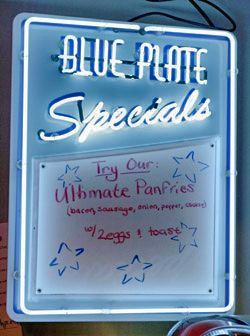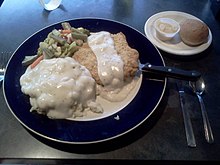Blue-plate special

A blue-plate special is a discount-priced meal that usually changes daily: a term used in the United States and Canada by restaurants, especially diners and cafes.
The practice was very common from the 1920s through the 1950s. As of 2007[update], there are still a few restaurants and diners that offer blue-plate specials under that name, sometimes on blue plates, but it is a vanishing tradition. However, the phrase is still a common American colloquialism.[citation needed]
A collection of 1930s prose gives this definition: "A Blue Plate Special is a low-priced daily diner special — a main course with all the fixins, a daily combo, a square for two bits."[1]
History
The origin and explanation of the phrase are unclear.
The term became common starting in the late 1920s. A May 27, 1926, advertisement in

"No substitutions" was a common policy on blue-plate specials. One 1947 Candid Microphone episode features Allen Funt ordering a blue-plate special and trying to talk the waiter into making various changes, such as replacing the vegetable soup with consommé, while the polite but increasingly annoyed waiter tries in vain to explain to Funt that "no substitutions" means what it says. Our Man in Havana (1958) by Graham Greene has the following exchange regarding an "American blue-plate lunch":
"Surely you know what a blue-plate is, man? They shove the whole meal at you under your nose, already dished up on your plate – roast turkey, cranberry sauce, sausages and carrots and French fried. I can't bear French fried but there's no pick and choose with a blue-plate."
"No pick and choose?"
"You eat what you're given. That's democracy, man."
Contemporary usage

In contemporary usage, a "blue-plate special" can be any inexpensive full meal, a daily special, or merely a whimsical phrase[5] for a home meal composed of odds and ends or leftovers.
In film and television
In the 1973 film The Sting, Robert Redford's character Johnny "Kelly" Hooker orders the blue-plate special at the diner. In the 1974 film The Front Page, condemned killer Earl Williams is said to be getting a "95-cent blue plate special from the greasy spoon across the street" for his last meal. In the 1997 movie Good Will Hunting Matt Damon's character references a "blue plate special" in one of the movie's more memorable monologues when explaining why he does not wish to work for the government. In the television series Double Dare, one obstacle on the final course is called the Blue Plate Special. In The Devil All The Time[6] (Netflix), Willard is offered the meatloaf "blue plate special" by the waitress in the Wooden Spoon Diner in Meade, Ohio; he opts instead for coffee and a doughnut. In The X-Files, Skinner orders a “blue plate special” in a diner, just before getting shot.
In print
In Graham Greene's Our Man in Havana (first published in 1958), the protagonist, Mr Wormold, is almost poisoned by a rival while eating a blue-plate lunch at a meeting of the European Traders' Association.[7]
In the Blondie comic strip for July 8, 1964, Dagwood is curious about the blue plate special being served on a white plate, and the explanation is that it's named after the cook, Oscar Blueplate.[8]
Richard Bernstein titled his New York Times review of Andrew Hurley's book Diners, Bowling Alleys, and Trailer Parks (2001),[9] "The Red, White and Blue Plate Special".[10]
Road food experts Jane and Michael Stern titled their guidebook Blue Plate Specials and Blue Ribbon Chefs: The Heart And Soul of America's Great Roadside Restaurants (2001).[11]
See also
References
- ^ White, Sarah (2001). "Anthology of Thirties Prose". 1930s Project. University of Virginia. Archived from the original on October 23, 2019. Retrieved February 7, 2012.
- ^ Quinlon, Michael Quinion. "Blue-Plate Special". World Wide Words.
- ^ Damon Runyon (1934). Damon Runyon's Blue plate special. F. A. Stokes.
- ISBN 978-0-8129-1059-9.
- ^ Curtis, Wayne (July 2, 2000). "WHAT'S DOING IN; Portland, Me". The New York Times.
- ^ "The Devil All The Time".
- ISBN 9780099286080.
- ^ "Blondie". Globe and Mail. Toronto. 1964-07-08. p. 37.
- ^ Hurley, Andrew. Diners, Bowling Alleys and Trailer Parks: Chasing the American Dream in Postwar Consumer Culture.
- ^ Bernstein, Richard (March 14, 2001). "BOOKS OF THE TIMES; The Red, White and Blue Plate Special". The New York Times.
- ISBN 0867308400.
External links
- Blue Plate Special, anyone? Kevin Reed's article
- Blue Plate Special A competing explanation by Michael Quinion
- Blue Plate Special "a square for two bits"
- Children's museum show (sponsorship by Blue Cross mentioned elsewhere)
- WREK Sound Blocks (Georgia Tech's WREK radio)
